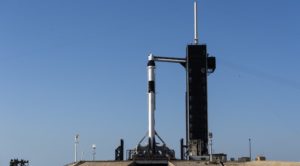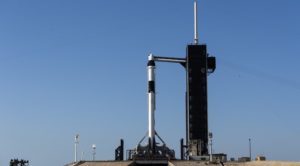WASHINGTON — As SpaceX and NASA complete final preparations for this Crew Dragon spacecraft’s first flight, the bureau is awaiting the next assignment of the spacecraft.
Technicians spent the afternoon May 26 wrapping up work before their scheduled 4:33 p.m. Eastern May 27 launching of this Crew Dragon spacecraft about the Demo-2 assignment. That included lowering the Falcon 9 rocket from the vertical to a horizontal position for exactly what NASA described as an inspection of a water radiator system used to maintain the spacecraft cool, in Launch Complex 39A. The work was completed along with the rocket returned into the vertical position later.
The probability of launch weather that was acceptable, increased from 40% to 60 percent in a prediction issued May 26. That prediction, though, does not include weather in abort sites downrange, which could scrub a launch even if weather conditions are acceptable at the launching site.
“This is a significant problem,” he explained. “We need to be sure we provide permission to say no.”
He contended that desire to make sure people are empowered to speak up is 1 reason NASA finalized a deal with Roscosmos earlier in the month to get a Soyuz seat on a mission launch in October, an agreement that will cost NASA greater than $90.2 million. “We want people to don’t hesitate to say no, and not feel some pressure to go with this launching.”
Assuming there are no problems that halt the launch, astronauts Bob Behnken and Doug Hurley will wake up around 9 a.m. Eastern on launching day, stated Norm Knight, deputy manager for flight operations in the Johnson Space Center, during a May 25 briefing. They will go through clinical checks, have breakfast, and get final briefings before suiting up and leaving the operations building shortly after 1 p.m. Eastern.
The astronauts will go to the pad at Tesla Model X electric automobiles adorned with both NASA’s”meatball” and”pig” logos, the latter brought from a nearly three-decade retirement especially for this assignment. Launch controllers will provide final acceptance 45 minutes prior to the scheduled 4:33 p.m. liftoff to proceed with the fueling of the Falcon 9 rocket.
Demo-2 was initially meant to spend only a couple weeks in distance and is designed to be an evaluation flight to confirm the spacecraft’s functioning. However, NASA has decided to extend the mission, Chris Cassidy, by a span to be determined to permit Behnken and Hurley to help the sole NASA astronaut there.
The highest priority would be to test the vehicle and make it home safely, and be prepared to start Crew-1,” Bridenstine explained. Crew-1 is the designation to its very first operational Crew Dragon assignment, which will ship three NASA astronauts and a single astronaut.
Bridenstine revealed in the May 26 briefing that NASA is currently targeting an Aug. 30 launching for Crew-1, a date that is dependent upon when the Crew Dragon spacecraft for this assignment is ready. Before Crew-1 can start the Demo-2 assignment will need to return earlier that launch date so it can be inspected and the spacecraft certified by NASA for operational missions.
“They can be there probably until early August,” Bridenstine stated of this Demo-2 mission. The specific duration of this assignment will be contingent on the performance of the Demo-2 spacecraft, launch readiness for your Crew-1 assignment, and weather conditions in the place in the Atlantic Ocean. “When we’ve got a good window to come home and they are not necessarily about the International Space Station, we will be taking it.”
“There is a great deal of flexibility built into the rear end of this assignment, but that is intentional,” he explained, speaking to the uncertain duration of this Demo-2 mission. Surely that is OK if they can do much more work than this while they are about the ISS. However, this is a test flight.”
– Advertisement –


